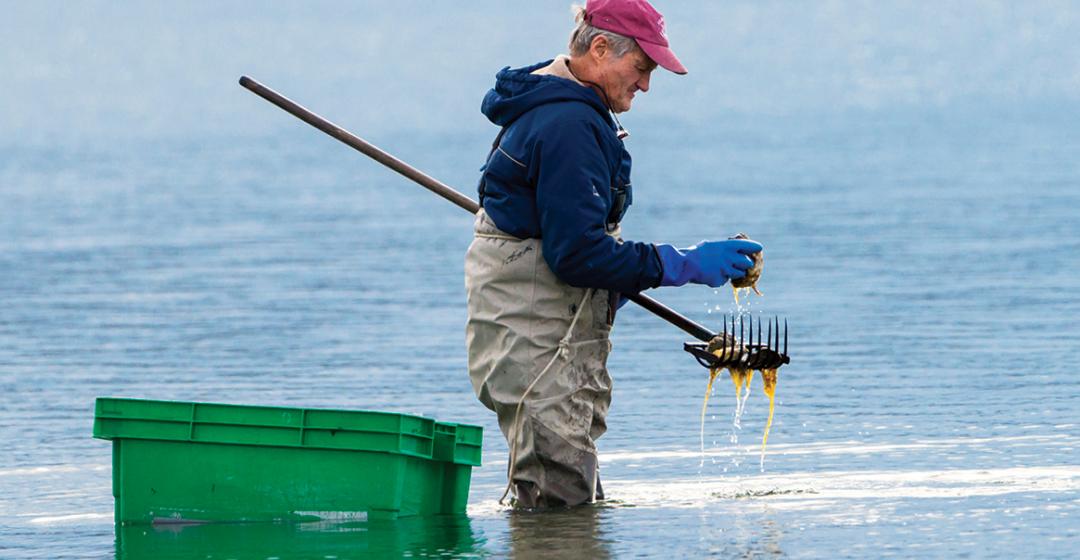Clamming on Martha’s Vineyard in the off-season is a pleasant and rewarding outdoor pursuit. By December, fair weather vacationers and great white sharks have headed south for warmer waters, which leaves only the cold to be concerned about. With just a modicum of effort, and minimum equipment, most anyone can expect to return with dinner and avoid hypothermia.
The six Island towns spend a fair amount of tax dollars to enhance and protect their shellfish resources. Depending on the municipality and body of water, sweet bay scallops, tasty quahaugs, succulent steamers, and briny oysters may be available for harvest by wading in shallow water with the appropriate gear.
A town shellfish license is mandatory. The cost varies depending on the town and one’s residency status, but it is a bargain for those who enjoy fresh air and fresh seafood – and want an excuse to get out of the house on a pleasant winter day.
I focus on deer until the end of hunting season in December. Waterfowl season carries me a few weeks into January. Now what to do?
If the temperature is above 40 degrees, the wind is light, and low tide coincides with the relative warmth of the noon winter sun, I head to Tashmoo Pond in Vineyard Haven. The small bay that was crowded with boats in the summer is mostly vacant and silent, save for the geese that call it home.
In about one hour I usually gather enough clams to make a hearty pot of quahaug chowder. The act of drawing the rake through the sand while standing in the water beneath a crystal-blue winter sky until I feel the distinct “tick” of a tine striking a hard shell is meditative. Sitting down to a steaming bowl of homemade chowder with clams I harvested earlier that day is pure joy.
Quahaugs (hard-shell clams), steamers (soft-shells), oysters, or scallops – each mollusk presents its own set of harvesting challenges and specific equipment requirements. However, unless you have tempered your extremities during the summer in Arctic waters (or Maine), you will want a pair of neoprene waders, which provide insulation and floatation, to get started.
It is also wise to be familiar with the body of water where you plan to shellfish, or to go with someone who knows the channels and deep holes to avoid. The shellfish constable in each town can advise you of the most productive areas.
Quahaugs are one of the easiest shellfish to harvest and eat. They are widespread and often found in easily accessible shallow flats. Bear in mind that size matters when it comes to whether Mercenaria mercenaria is described as a little neck, a cherrystone, or a chowder (or when in doubt, a quahaug).
The key piece of equipment is a rake. Don’t skimp. Expect to spend at least $80 for a quality long-handled rake that will last a decade or more.
Those new to clamming often hold the rake as though they are sweeping with a broom, which affects how deeply the tines probe the sand. The most effective and least tiring technique is to hold the rake handle by the end and draw the tines slowly across the bottom until you feel them scrape over a clam. Then repeat the motion and “rake” up the clam into the rake basket. With a little practice it becomes easy to differentiate between stones and clams.
Each town sets specific harvest limits and seasons. For example, Tisbury, Oak Bluffs, and Edgartown allow a recreational license holder to take one-half bushel basket of quahaugs per week. That translates into approximately 175 littlenecks, 90 cherrystones, or 60 chowders, depending on size, more than enough for a feast. My galvanized wire basket has a float collar and a line that I clip to my wader belt so I can easily pull it along behind me as I wade and rake.
In addition, shellfishermen are required to carry a shellfish gauge, a square piece of metal with a rectangular cut-out that allows clams that do not meet the minimum thickness of one inch to pass through it.
The beauty of clamming is its simplicity. That applies once you arrive back in the kitchen.
Opening an oyster can be a struggle. It takes practice. And there is always the risk you will plunge the sharp point of an oyster knife into your palm – I speak from experience on that one.
Shucking a scallop is an art form. It takes practice and dexterity to remove the scallop guts from around the sweet, pulsing muscle meat. The first bushel I ever harvested took me about four hours to shuck. By the time I was finished my hand was cramped into the shape of a claw.
Opening a hard shell clam is a matter of placing your harvest in the refrigerator until it is well chilled and relaxed. A cold clam is a happy clam and is relatively easy to open with a clam knife as long as you do not handle the shell too much, causing it to “clam up.” Or you can simply sauté your little necks or cherrystones in wine and butter until they open up of their own accord. Larger size clams are best used for chowder or fritters. Yum.




 1 comment
1 comment
Comments (1)